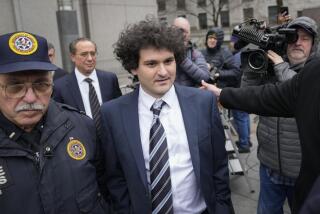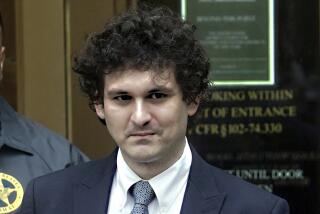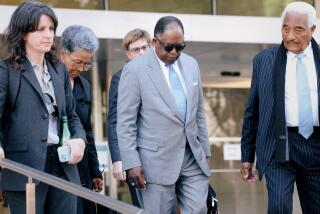Andersen Found Guilty of Obstruction
- Share via
HOUSTON — A federal jury convicted accounting firm Arthur Andersen of obstruction of justice Saturday, sending the firm to the brink of extinction and giving the Justice Department a crucial win in its criminal probe of Enron Corp.
Jurors said the verdict arose not from Andersen’s shredding of Enron documents--the crux of the government’s case--but from the actions of an Andersen staff attorney who has not been charged and who invoked her right not to testify at the trial.
The jury of nine men and three women deliberated for about 72 hours over 10 days before reaching a unanimous decision. Andersen, long ago revered as the conscience of the accounting industry, becomes the first major auditor convicted of a felony.
Sentencing is set for Oct. 11, when the firm could face a $500,000 fine. The Securities and Exchange Commission also was expected to bar the 89-year-old firm from auditing public companies as a result of the verdict, but Andersen notified the SEC on Saturday that it would cease those audits by Aug. 31.
Andersen already has lost its biggest clients, but the firm nonetheless said it plans to appeal, citing what it called U.S. District Judge Melinda Harmon’s flawed jury instructions and evidence rulings.
Deputy U.S. Atty. Gen. Larry Thompson said the evidence in the case proved that “Andersen intentionally interfered with an official investigation concerning Andersen’s client Enron Corp. when it destroyed tons of papers, documents and a large quantity of electronic information” last fall.
But at a news conference after the verdict, four jurors said document destruction was not the key factor in their decision. The jurors said they voted to convict because they believed that Andersen staff attorney Nancy Temple had criminal intent when she urged Houston-based auditor David B. Duncan on Oct. 16 to revise an internal memo regarding a damaging Enron earnings release.
The memo documented a dispute about how Enron should classify about $1 billion in charges against earnings that it would be disclosing in a third-quarter press release. Enron wanted to downplay the charges by characterizing them as nonrecurring, but Andersen auditors believed that description could be misleading to investors because the losses stemmed from the energy trader’s core business.
In the memo, Duncan wrote that he informed Enron Chief Accounting Officer Richard A. Causey of Andersen’s concerns, but Enron used the term nonrecurring anyway. Enron’s news release disclosed for the first time the extent of losses from its off-balance-sheet partnerships and triggered the energy giant’s collapse.
In her Oct. 16 e-mail, Temple asked Duncan to remove her name from the list of recipients of his memo because she feared being called as a witness in litigation, and asked him to delete language suggesting that Andersen found the release “misleading.”
Jury foreman Oscar Criner, a computer science professor at Texas Southern University, said the panel largely dismissed the prosecution’s evidence of document destruction and its star witness, Duncan. Criner said jurors concluded the altered internal memo, however, was “a smoking gun.”
“Arthur Andersen did not approve that [press release], and Enron went along anyway and did it,” Criner said. “Then Arthur Andersen set about to change things, to alter documents to keep [information] away from the SEC.”
During the trial, prosecutors cited the Oct. 16 e-mail from Temple to Duncan as evidence the firm feared an SEC inquiry and had a motive to shred documents. But prosecutors hadn’t argued that Temple’s directive was an act of obstruction. The March 7 indictment of the firm centered on Andersen’s “wholesale destruction” of documents and makes no mention of Temple’s instruction to alter the memo.
But outside the courthouse, Assistant U.S. Atty. Andrew Weissmann said the drafts of Duncan’s internal memo, which reflected the sequence of the changes, were “exactly what was intended to be destroyed” in the firm’s shredding. Weissmann said the memo was “a terrific document” for the jury to examine in considering its decision.
Andersen attorneys expressed disbelief at the jury’s logic but said it meant that jurors had rejected the prosecutors’ main argument--that Andersen shredded documents to impede the SEC.
I take the jury’s remarks [as] a complete vindication of Andersen’s position,” said defense attorney Charles Rothfeld. “It’s bizarre.”
Defense lawyers also noted that the firm didn’t learn of the SEC inquiry into Enron until Oct. 19, three days after Temple sent her e-mail to Duncan.
Andersen lawyers further suggested that jurors acted under duress. After seven days of deliberations, the jury told the court Wednesday that it was deadlocked. That prompted Harmon to give them the so-called Allen charge, urging them to continue deliberating in hopes of avoiding a hung jury and a mistrial.
Andersen lead attorney Rusty Hardin vowed to appeal but noted that an appeal could not be filed until after Andersen’s sentencing.
Hardin said the indictment of the firm raised “serious, troubling” questions for corporations considering notifying authorities of potential crimes committed by their own employees. Andersen had notified the Justice Department of its destruction of Enron-related files.
*
Defections Leave Future of Andersen in Doubt
Andersen’s immediate future was not clear. The firm has hired a reorganization specialist and has signed a letter of intent to sell its consulting practice to KPMG. Most of its major clients already have signed with other firms, and industry experts believe that Andersen eventually will file for bankruptcy.
The company, once 26,000 strong, now is down to about 10,000 employees.
“When clients go, the people have to follow,” said Avedick Poladian, senior managing partner of Andersen’s Los Angeles office.
C.E. Andrews, a top partner who attended much of the trial, said outside court that the firm would “regroup and reassess” its future.
“We do not regret going through this trial,” Andrews said.
Even without the guilty verdict, accounting industry experts had predicted Andersen’s demise because it had lost too many clients and partners to carry on as a viable major firm. But conviction was seen as a fatal blow, because it would deny Andersen the ability to audit its biggest customers--publicly traded companies.
Justice Department officials have not ruled out further action against Andersen and its executives amid the continuing investigation into Enron’s collapse, which cost thousands of jobs and billions of dollars in investment and retirement losses.
“We’re still looking at everything. We’re not finished with Arthur Andersen,” Leslie Caldwell, chief of the Justice Department’s Enron task force, said in Houston on Saturday.
Caldwell and others said the conviction gives the government momentum in its Enron probe. But some observers said the trial exposed holes in the government’s case going forward.
The prosecution’s key witness, Duncan, vouched for much of his firm’s auditing conclusions, opening up a possible defense if prosecutors decided to pursue accounting-fraud charges against former Enron executives. Moreover, the length of deliberations suggested that the Justice Department’s evidence is far from overwhelming, some legal experts said.
“If you can’t win a conviction in an hour in Harris County, Texas, where Andersen and Enron teamed up to hurt a lot of people, you’ve got problems,” said David Berg, a veteran Houston attorney who monitored the case. Berg added that if he were representing any potential defendants, “I would be putting on my jury trial suit.”
*
Firm Faced Uphill Battle in Courtroom
Andersen faced tough obstacles heading into court. The undisputed facts of the case appeared to tilt against Andersen: on Oct. 23, after he learned of an SEC inquiry into Enron, Duncan summoned his lieutenants and directed them to comply with Andersen’s document policy, which called for discarding drafts and other records deemed unnecessary. Moreover, prosecutors had to prove only that a single Andersen executive acted with criminal intent in persuading another employee to shred documents.
Prosecutors gained another edge by winning an early procedural battle, obtaining permission to introduce previous Andersen audit failures from clients Waste Management Inc. and Sunbeam Corp. as evidence of motive to obstruct. In court, prosecutors said the accounting firm, on corporate probation for those earlier problems, knew that fallout from Enron’s questionable accounting might lead to a sort of third strike against it and result in harsher sanctions.
The firm’s legal department then devised a way to shield Andersen from regulators and investor lawsuits, prosecutors said: Temple on Oct. 12 urged the Enron audit team to comply with the firm’s little-invoked document-retention policy. By suddenly instructing auditors to apply the policy to their Enron files in October, prosecutors said, the firm acted with intent to shred documents of keen interest to the SEC.
Andersen’s defense team argued that no one at the firm acted with criminal intent. The firm said the Oct. 12 e-mail from Temple was intended to encourage accountants to properly document internal discussions. Andersen executives in Houston, the firm said, believed they needed to finalize and organize their files to respond to potential accounting questions from their superiors in Chicago, or from Enron management.
In the minds of the jury, the two sides apparently fought to a draw--at least initially. Jurors said they took a vote almost immediately after deliberations began and found themselves split about even.
After a week of debate, they notified Harmon that they were unable to reach a unanimous decision. Harmon then implored them to reach a verdict “without surrendering your conscientious conviction.”
*
Jurors Sought Aid in Reaching Verdict
The next day, the jurors sent a note asking whether they could find the firm guilty even if they could not agree on which of Andersen’s employees had the intent to impede the SEC inquiry. After an impassioned debate by the two sides, Harmon issued a ruling that favored the prosecution, instructing the panel that they did not have to agree on who the guilty executive was, as long as they all believed that someone at Andersen was guilty.
But in interviews Saturday and in their answers on a court verdict form, the jurors said Harmon’s decision ultimately had no bearing on their decision because they had come to agree that Temple was the one with the required intent.
Throughout the six-week trial, Andersen had signaled that it was gathering ammunition for a possible appeal. Hardin has said Harmon erred by allowing prosecutors to present evidence related to its audits of Waste Management Inc. and Sunbeam Corp. He also said the judge created “reversible error” by letting the government discuss personal notes taken by Temple, who had invoked her 5th Amendment right.
But prosecutors said they were confident the verdict would stand.
The court record would be “extremely solid on appeal,” said Assistant U.S. Atty. Samuel Buell. He added that the verdict should serve as warning to the accounting industry to “get their priorities straight.”
*
(BEGIN TEXT OF INFOBOX)
Path to the Verdict
Here are key dates in the Arthur Andersen case.
Feb. 5, 2001 Arthur Andersen executives consider dropping Enron Corp. as a client over the company’s questionable accounting but ultimately decide to retain the energy trader.
Aug. 14 Jeffrey K. Skilling resigns as Enron chief executive after six months on the job, triggering concerns about the company’s financial health.
Aug. 20 Enron Vice President Sherron S. Watkins, a former Andersen executive, calls Andersen audit partner James Hecker to voice concern over Enron’s accounting.
Oct. 16 Enron reports a $638-million third-quarter loss and a $1.2-billion writedown in equity.
Oct. 22 Enron discloses a Securities and Exchange Commission inquiry into its partnerships.
Dec. 2 Enron files for Chapter 11 bankruptcy protection.
Jan. 10, 2002 Andersen admits it destroyed a “significant” number of Enron audit documents.
Jan. 15 Andersen fires Enron audit team leader David B. Duncan, saying he organized an effort to destroy thousands of documents.
Jan. 28 Andersen Chief Executive Joseph F. Berardino says the firm is losing clients.
Feb. 3 Andersen hires former Federal Reserve Board Chairman Paul A. Volcker to overhaul the firm.
March 14 The Justice Department charges Andersen with one count of obstructing justice for shredding Enron-related documents.
March 20 Andersen pleads not guilty.
March 26 Berardino resigns as client defections accelerate.
March 27 Andersen executives say they will accept a restructuring plan proposed by Volcker to split its auditing and consulting practices.
March 29 Andersen seeks settlement talks with the Justice Department.
April 3 Andersen hires investment bank Gleacher Partners to weigh options, including bankruptcy.
April 8 Andersen fires 7,000 workers.
April 9 Duncan pleads guilty to obstruction and agrees to cooperate with prosecutors.
April 22 Andersen discloses hiring of restructuring expert Bryan Marsal to oversee reorganization.
April 25 Justice Department rejects Andersen’s settlement offer.
May 3 Volcker suspends efforts to save Andersen.
May 6 Andersen;s obstruction-of-justice trial begins in the courtroom of U.S. District Judge Melinda Harmon in Houston. The defense is led by Rusty Hardin, the prosecution by Samuel Buell and Andrew Weissmann.
May 13 Duncan testifies, saying he orchestrated an effort to destroy Enron documents.
June 5 Prosecution and defense teams conclude their arguments; the case goes to the jury.
June 15 Jury convicts Andersen of obstruction.
*
More to Read
Inside the business of entertainment
The Wide Shot brings you news, analysis and insights on everything from streaming wars to production — and what it all means for the future.
You may occasionally receive promotional content from the Los Angeles Times.










